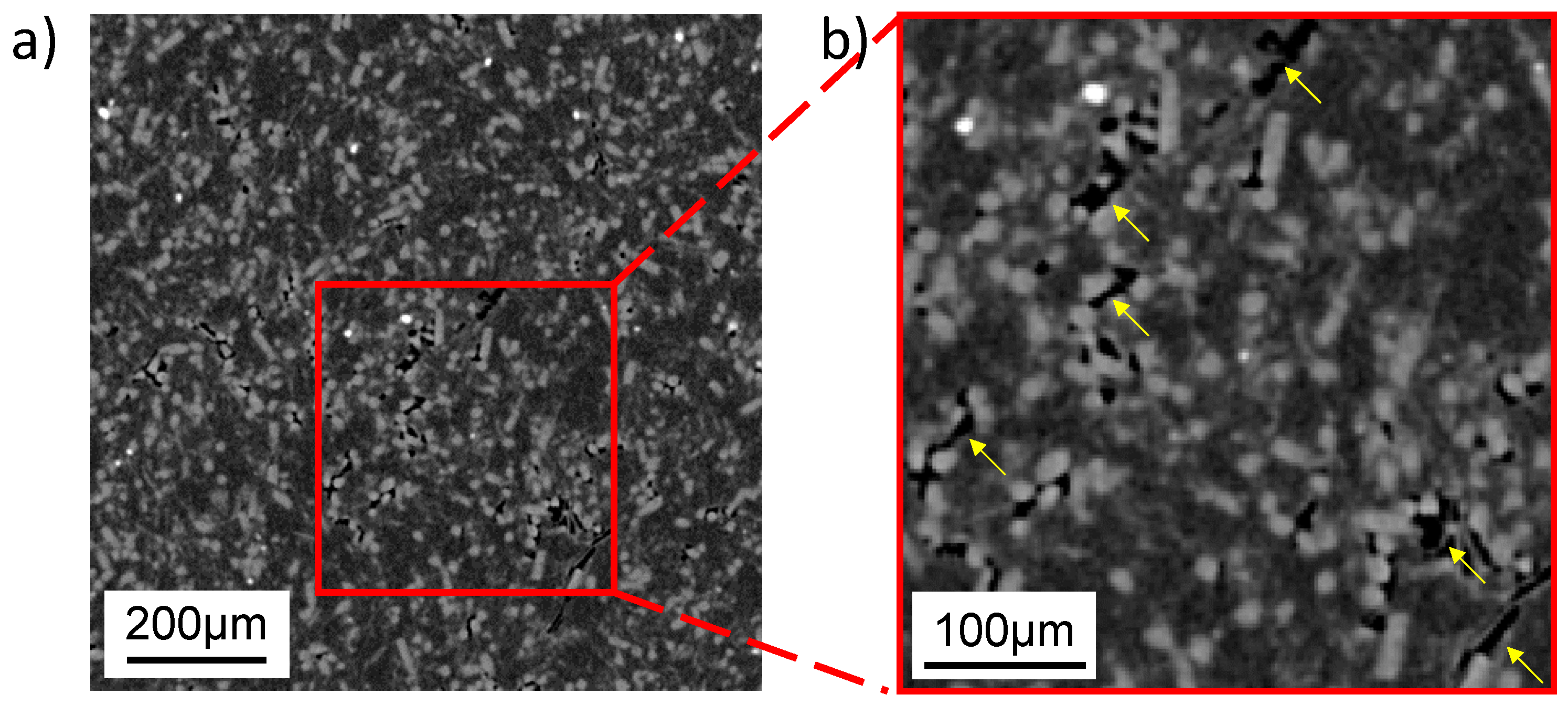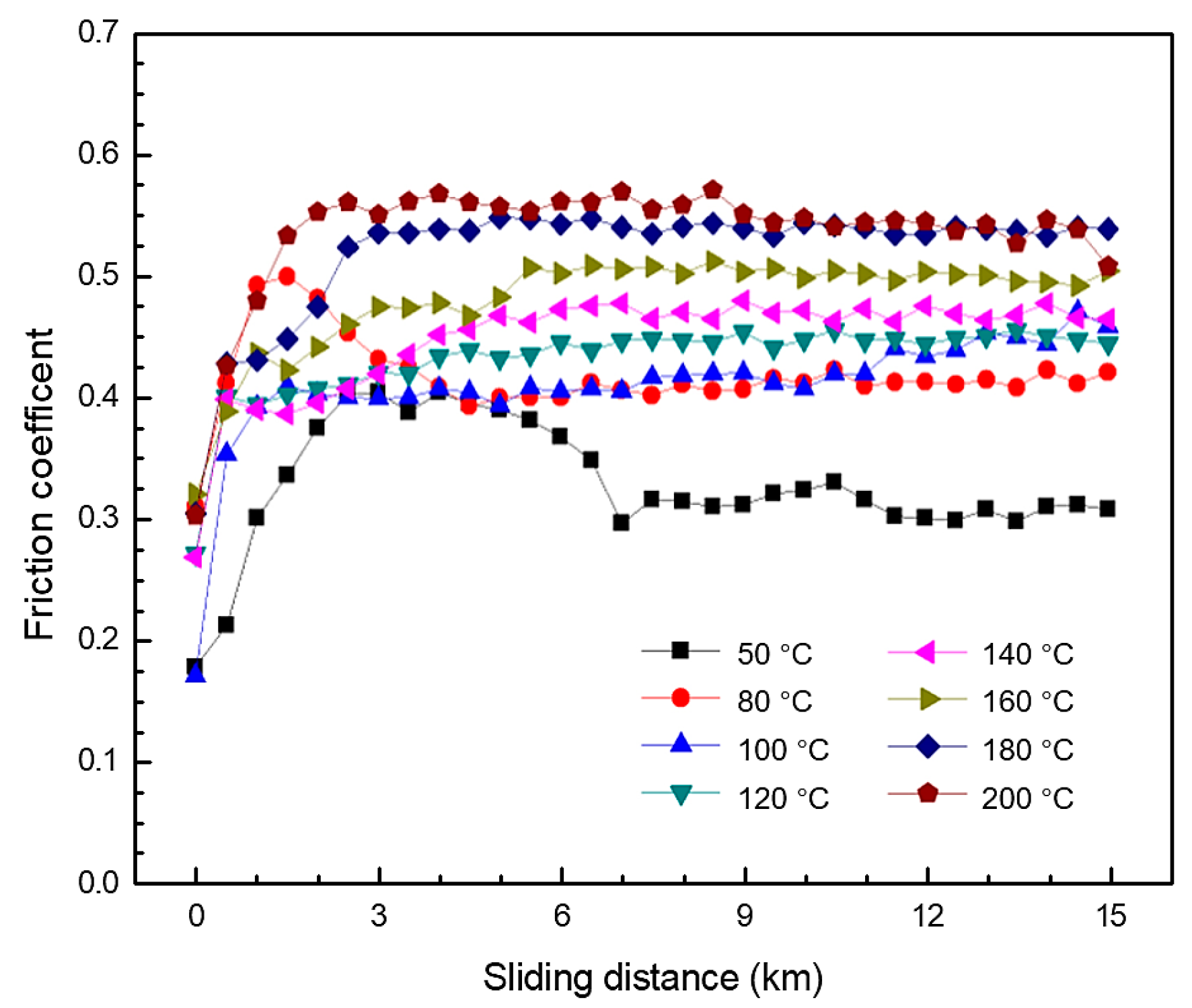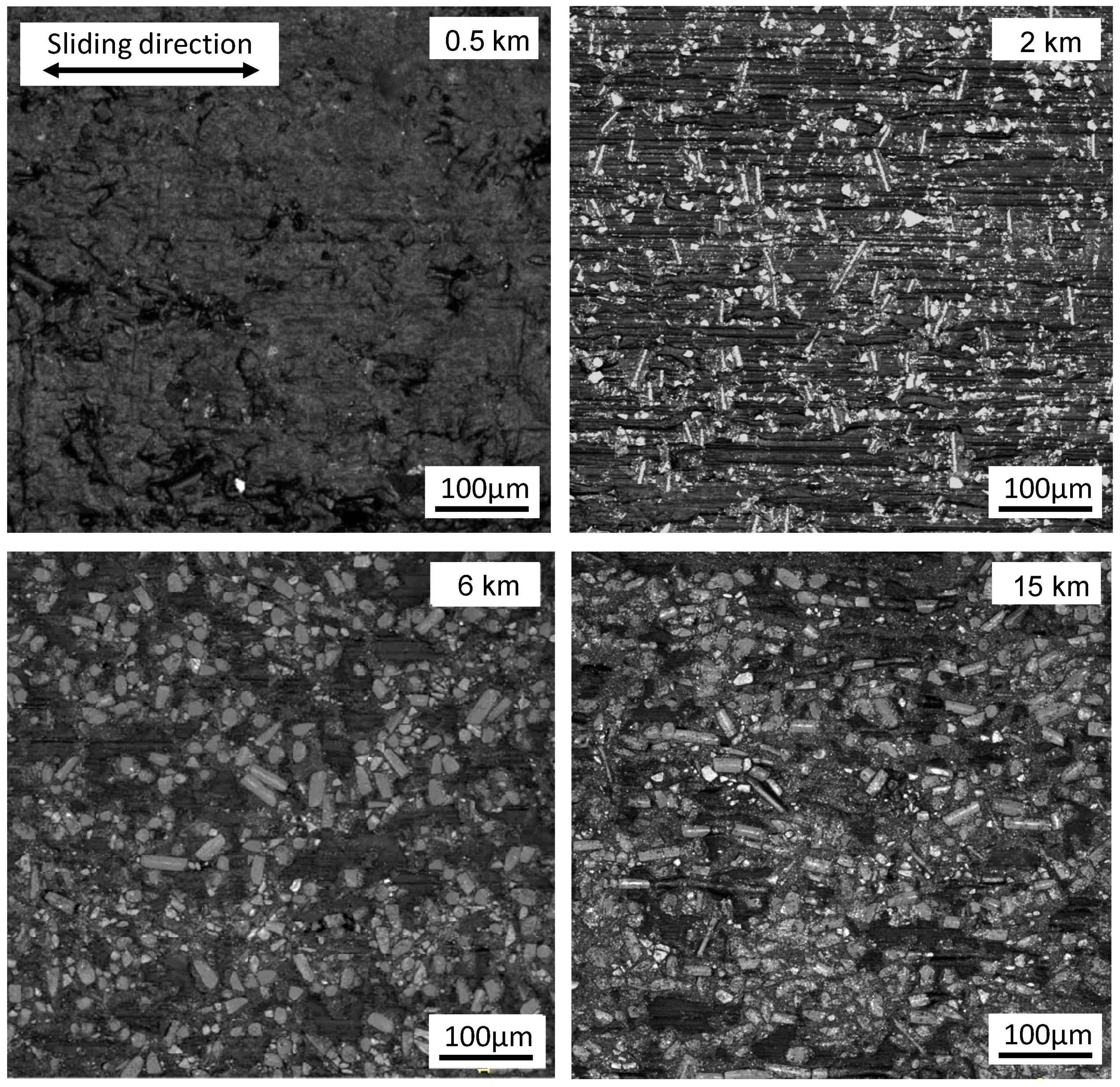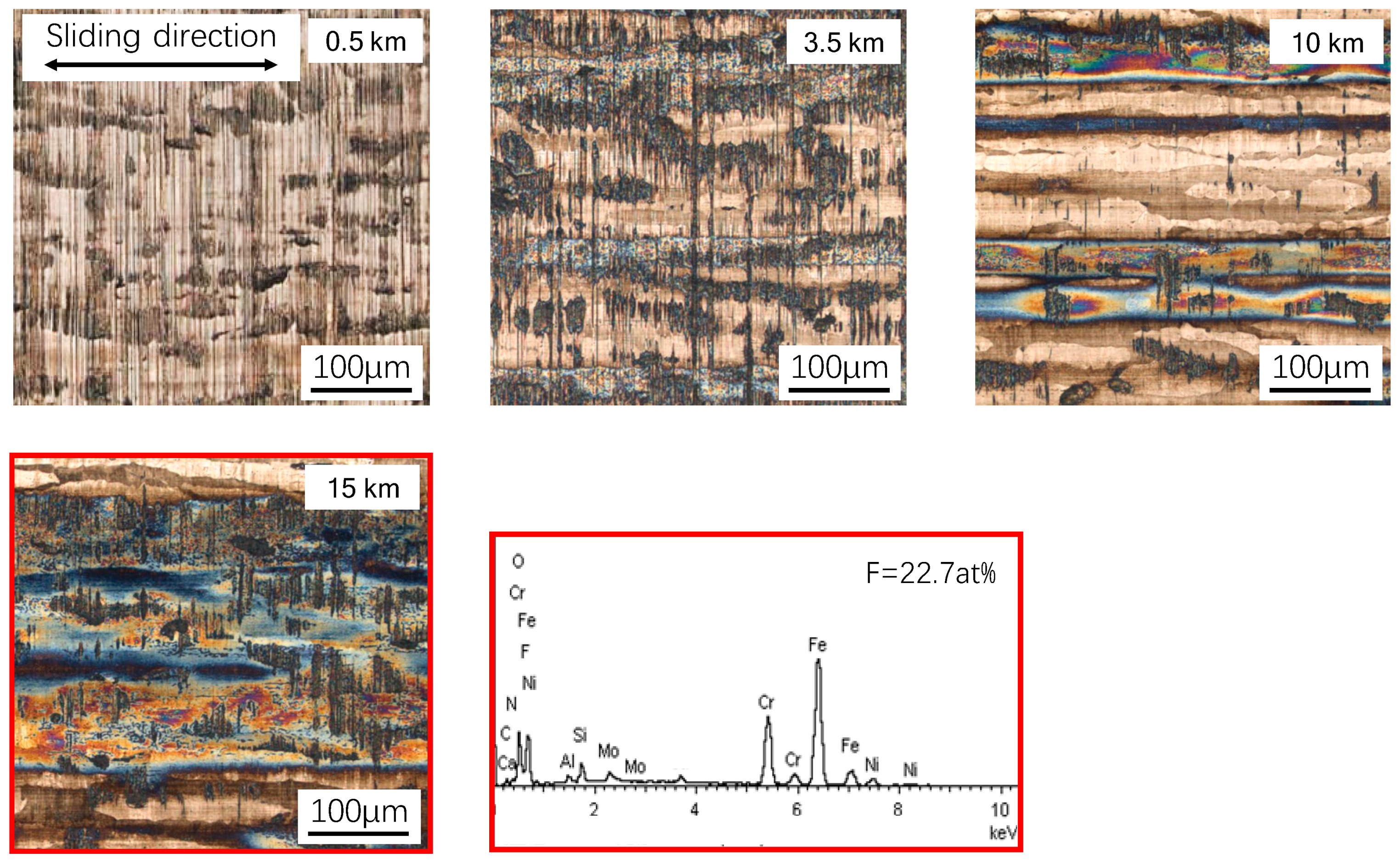Wear Evolution of the Glass Fiber-Reinforced PTFE under Dry Sliding and Elevated Temperature
Abstract
:1. Introduction
2. Materials and Methods
2.1. Materials and Specimens
2.2. Friction Testing
2.3. Interrupted Wear Testing
3. Results
3.1. The Internal Microstructure of the GFRPTFE Specimen
3.2. Effect of Temperature on the Friction and Wear Rate of GFRPTFE
3.3. The Surface Wear Evolution of the GFRPTFE at Elevated Temperatures
3.4. The Development of the Transfer Film on the Steel Counter-Face at Elevated Temperature
4. Discussion
5. Conclusions
Author Contributions
Funding
Acknowledgments
Conflicts of Interest
References
- Khare, H.S.; Moore, A.C.; Haidar, D.R.; Gong, L.; Ye, J.; Rabolt, J.F.; Burris, D.L. Interrelated Effects of Temperature and Environment on Wear and Tribochemistry of an Ultralow Wear PTFE Composite. J. Phys. Chem. C 2015, 119, 16518–16527. [Google Scholar] [CrossRef]
- Song, F.; Wang, Q.; Wang, T. Effects of glass fiber and molybdenum disulfide on tribological behaviors and PV limit of chopped carbon fiber reinforced Polytetrafluoroethylene composites. Tribol. Int. 2016, 104, 392–401. [Google Scholar] [CrossRef]
- Blanchet, T.A.; Kennedy, F.E. Sliding wear mechanism of polytetrafluoroethylene (PTFE) and PTFE composites. Wear 1992, 153, 229–243. [Google Scholar] [CrossRef]
- Kim, S.S.; Shin, M.W.; Jang, H. Tribological properties of short glass fiber reinforced polyamide 12 sliding on medium carbon steel. Wear 2012, 274–275, 34–42. [Google Scholar] [CrossRef]
- Conte, M.; Igartua, A. Study of PTFE composites tribological behavior. Wear 2012, 296, 568–574. [Google Scholar] [CrossRef]
- Cheng, X.-H.; Xue, Y.-J.; Xie, C.-Y. Friction and wear of rare-earth modified glass-fiber filled PTFE composites in dry reciprocating sliding motion with impact loads. Wear 2002, 253, 869–877. [Google Scholar] [CrossRef]
- Shi, Y.; Feng, X.; Wang, H.; Lu, X. Tribological properties of PTFE composites filled with surface-treated carbon fiber. J. Mater. Sci. 2007, 42, 8465–8469. [Google Scholar] [CrossRef]
- Mu, L.; Xin, F.; Zhu, J.; Wang, H.; Sun, Q.; Shi, Y.; Lu, X. Comparative Study of Tribological Properties with Different Fibers Reinforced PTFE/PEEK Composites at Elevated Temperatures. Tribol. T. 2010, 53, 189–194. [Google Scholar] [CrossRef]
- Yuan, Q.; Jun, G.; Wenhan, C.; Honggang, W.; Junfang, R.; Gui, G. Tribological Behavior of PTFE Composites Filled with PEEK and Nano-Al2O3. Tribol. T. 2018, 61, 694–704. [Google Scholar] [CrossRef]
- Makowiec, M.E.; Blanchet, T.A. Improved wear resistance of nanotube- and other carbon-filled PTFE composites. Wear 2017, 374–375, 77–85. [Google Scholar] [CrossRef]
- Qiu, M.; Yang, Z.; Lu, J.; Li, Y.; Zhou, D. Influence of step load on tribological properties of self-lubricating radial spherical plain bearings with PTFE fabric liner. Tribol. Int. 2017, 113, 344–353. [Google Scholar] [CrossRef]
- Sripakagorn, A.; Srikam, C. Design and performance of a moderate temperature difference Stirling engine. Renew. Energy 2011, 36, 1728–1733. [Google Scholar] [CrossRef]
- Shen, Y.; Yu, B.; Lv, Y.; Li, B. Comparison of Heavy-Duty Scuffing Behavior between Chromium-Based Ceramic Composite and Nickel-Chromium-Molybdenum-Coated Ring Sliding against Cast Iron Liner under Starvation. Materials 2017, 10, 1176. [Google Scholar] [CrossRef] [PubMed]
- Ma, S.; Chen, W.; Li, C.; Jin, M.; Huang, R.; Xu, J. Wear Properties and Scuffing Resistance of the Cr–Al2O3 Coated Piston Rings: The Effect of Convexity Position on Barrel Surface. J. Tribol. 2018, 141, 021301. [Google Scholar] [CrossRef]
- Shen, Y.; Lv, Y.; Li, B.; Huang, R.; Yu, B.; Wang, W.; Li, C.; Xu, J. Reciprocating electrolyte jet with prefabricated-mask machining micro-dimple arrays on cast iron cylinder liner. J. Mater. Process. Technol. 2019, 266, 329–338. [Google Scholar] [CrossRef]
- Kato, H.; Komai, K. Tribofilm formation and mild wear by tribo-sintering of nanometer-sized oxide particles on rubbing steel surfaces. Wear 2007, 262, 36–41. [Google Scholar] [CrossRef]
- Harris, K.L.; Pitenis, A.A.; Sawyer, W.G.; Krick, B.A.; Blackman, G.S.; Kasprzak, D.J.; Junk, C.P. PTFE Tribology and the Role of Mechanochemistry in the Development of Protective Surface Films. Macromolecules 2015, 48, 3739–3745. [Google Scholar] [CrossRef]
- Calleja, G.; Jourdan, A.; Ameduri, B.; Habas, J.P. Where is the glass transition temperature of poly(tetrafluoroethylene)? A new approach by dynamic rheometry and mechanical tests. Eur. Polym. J. 2013, 49, 2214–2222. [Google Scholar] [CrossRef] [Green Version]
- Lehnert, R.J.; Hendra, P.J.; Everall, N.; Clayden, N.J. Comparative quantitative study on the crystallinity of poly(tetrafluoroethylene) including Raman, infra-red and 19 F nuclear magnetic resonance spectroscopy. Polymer 1997, 38, 1521–1535. [Google Scholar] [CrossRef]
- Song, F.; Yang, Z.; Zhao, G.; Wang, Q.; Zhang, X.; Wang, T. Tribological performance of filled PTFE-based friction material for ultrasonic motor under different temperature and vacuum degrees. J. Appl. Polym. Sci. 2017, 134, 45358. [Google Scholar] [CrossRef]











| Engineering Information | |
|---|---|
| Temperature-Typical Range (°C) | −240/+288 |
| Maximum PV (continuous) (MPa·m/s) | 10,000 (0.35) * |
| Maximum P-psi (static) (MPa) | 1000 (6.9) * |
| Maximum V-SFM (no load) (m/s) | 400 (2) * |
| Water Absorption ASTM D570 | 0% |
| Flammability ASTM D635 | Non-Flammable |
| Chemical Resistance | Inert |
| Thermal Conductivity (W/m·k) | 0.33 |
| Thermal Expansion (26 °C to 149 °C) (×10−5 m/m °C) | Length 11.1 |
| Elongation ASTM D4894 | 175% |
| Tensile Strength ASTM D4894 (MPa) | 2000 psi (13.8) * |
| Deformation ASTM D621 | 5% (1500 psi-24 h·RT) |
| Specific Gravity ASTM D792 | 2.22 |
| Tested Specimens | Axial Length (mm) | Inner Diameter (mm) | Outer Diameter (mm) |
|---|---|---|---|
| GFRPTFE | 2 | 78 | 90 |
| Cylinder liner | 63 | 90 | 100 |
© 2019 by the authors. Licensee MDPI, Basel, Switzerland. This article is an open access article distributed under the terms and conditions of the Creative Commons Attribution (CC BY) license (http://creativecommons.org/licenses/by/4.0/).
Share and Cite
Huang, R.; Ma, S.; Zhang, M.; Yang, J.; Wang, D.; Zhang, L.; Xu, J. Wear Evolution of the Glass Fiber-Reinforced PTFE under Dry Sliding and Elevated Temperature. Materials 2019, 12, 1082. https://doi.org/10.3390/ma12071082
Huang R, Ma S, Zhang M, Yang J, Wang D, Zhang L, Xu J. Wear Evolution of the Glass Fiber-Reinforced PTFE under Dry Sliding and Elevated Temperature. Materials. 2019; 12(7):1082. https://doi.org/10.3390/ma12071082
Chicago/Turabian StyleHuang, Ruoxuan, Siqi Ma, Meidi Zhang, Jie Yang, Dehong Wang, Liang Zhang, and Jiujun Xu. 2019. "Wear Evolution of the Glass Fiber-Reinforced PTFE under Dry Sliding and Elevated Temperature" Materials 12, no. 7: 1082. https://doi.org/10.3390/ma12071082





